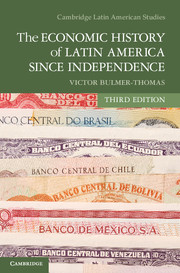Book contents
- Frontmatter
- Dedication
- Contents
- List of Tables, Figures, and Maps
- Preface to the Third Edition
- Preface to the First Edition
- List of Abbreviations
- 1 Latin American Economic Development
- 2 The Struggle for National Identity
- 3 The Export Sector and the World Economy, circa 1850–1914
- 4 Export-Led Growth
- 5 Export-Led Growth and the Nonexport Economy
- 6 The First World War and Its Aftermath
- 7 Policy, Performance, and Structural Change in the 1930s
- 8 War and the New International Economic Order
- 9 Inward-Looking Development in the Postwar Period
- 10 New Trade Strategies and Debt-Led Growth
- 11 Debt, Adjustment, and the Shift to a New Paradigm
- 12 Conclusions
- Appendix 1 Data Sources for Population and Exports before 1914
- Appendix 2 The Ratio of Exports to Gross Domestic Product, the Purchasing Power of Exports, the Net Barter Terms of Trade, and the Volume of Exports, circa 1850 to circa 1912
- Appendix 3 Population, Exports, Public Revenue, and GDP for the Main Latin American Countries before 1914
- Appendix 4 GDP Per Head in Latin America since 1900
- Bibliography
- Index
Appendix 2 - The Ratio of Exports to Gross Domestic Product, the Purchasing Power of Exports, the Net Barter Terms of Trade, and the Volume of Exports, circa 1850 to circa 1912
Published online by Cambridge University Press: 05 June 2014
- Frontmatter
- Dedication
- Contents
- List of Tables, Figures, and Maps
- Preface to the Third Edition
- Preface to the First Edition
- List of Abbreviations
- 1 Latin American Economic Development
- 2 The Struggle for National Identity
- 3 The Export Sector and the World Economy, circa 1850–1914
- 4 Export-Led Growth
- 5 Export-Led Growth and the Nonexport Economy
- 6 The First World War and Its Aftermath
- 7 Policy, Performance, and Structural Change in the 1930s
- 8 War and the New International Economic Order
- 9 Inward-Looking Development in the Postwar Period
- 10 New Trade Strategies and Debt-Led Growth
- 11 Debt, Adjustment, and the Shift to a New Paradigm
- 12 Conclusions
- Appendix 1 Data Sources for Population and Exports before 1914
- Appendix 2 The Ratio of Exports to Gross Domestic Product, the Purchasing Power of Exports, the Net Barter Terms of Trade, and the Volume of Exports, circa 1850 to circa 1912
- Appendix 3 Population, Exports, Public Revenue, and GDP for the Main Latin American Countries before 1914
- Appendix 4 GDP Per Head in Latin America since 1900
- Bibliography
- Index
Summary
The criteria used in Chapter 3 for measuring the success or failure of export-led growth require information on the ratio of exports to GDP, the price of imports, and the purchasing power of exports before 1914 for all countries. This Appendix 2 explains the methods I used to calculate the statistics. It also includes tables on export prices, the net barter terms of trade (NBTT), and the volume of exports from 1850 to 1912 (unless otherwise specified) for twelve countries.
The Ratio of Exports to GDP
Calculation of the required rate of growth of exports in equation (3.2) involves estimation of the ratio of exports to GDP (w). Because w can be assumed to change over time, it is necessary to estimate it at the beginning (circa 1850) and at the end (circa 1912) of the period.
The ratio of exports to GDP is the same as the ratio of exports per head to GDP per head. Table 3.6 provides data on exports per head in current dollars for all countries at different time intervals, and Appendix 4 provides data on GDP per head circa 1912 for nine countries at constant (2000) dollars. For some of these countries there are also estimates of GDP at current dollars (see Appendix 3), and it is preferable to use these for consistency because the export data are also at current prices. In the case of Mexico, I used a three-year average for 1908 to avoid the impact of the revolution; in the case of Venezuela, I used a three-year average for 1921 because the current price series starts in 1920 (in both cases exports per head therefore need to refer to the same year rather than to 1912). Estimates for ԝ in 1912 for other countries with constant price estimates can be obtained by converting the GDP data to current dollars using a deflator obtained from US wholesale price indexes; see Mitchell (2007). Assuming that 1970 equals 100, the 1912 price index can be calculated as 35. Thus the GDP data for these other countries were converted to current dollars by multiplying by 0.35. This allows calculation of ԝ in 1912 for any country for which there are constant price GDP data only.
- Type
- Chapter
- Information
- The Economic History of Latin America since Independence , pp. 465 - 479Publisher: Cambridge University PressPrint publication year: 2014



